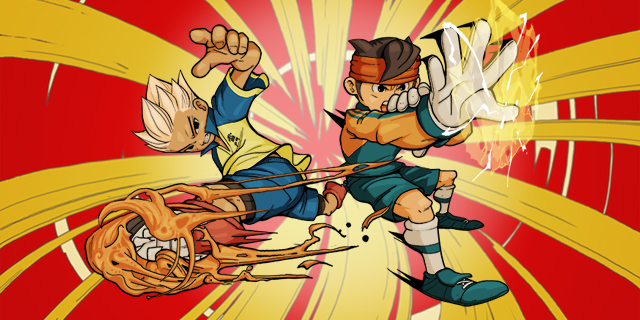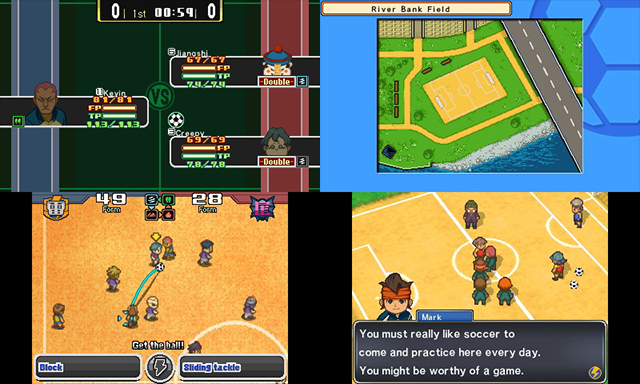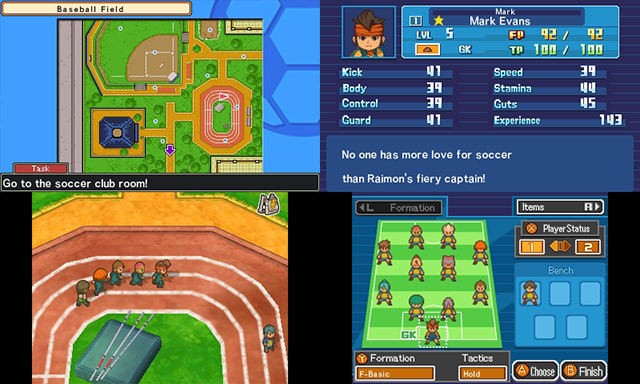
Level-5’s Inazuma Eleven series has enjoyed a long, fruitful life in Japan, and in recent years has also gained a foothold in Europe. This 3DS eShop release marks the first American appearance of the series, possibly because of the relative popularity of soccer in the region. Its appeal isn’t limited to footy fans, though: Inazuma Eleven may have a sports theme, but it’s really a deep, involved party-building RPG with an innovative battle system.
Inazuma Eleven follows the story of Mark Evans, a soccer-obsessed kid at Raimon Junior High, as he builds the school’s soccer club from the brink of disbandment to an elite force. The story itself is probably not why you’re here; in many ways, Inazuma‘s plot is that of a youth-focused anime, with character tropes, predictable twists and unexplained, often-latent superpowers. The moment-to-moment events and conversations are sometimes endearing and sometimes just a few seconds of meaningless text breaking up your action. Nevertheless, you’ll definitely have a few favorite characters, as the wide cast likely features personalities fit to your taste.
Most of the time, you’ll be playing in one of two ways: in full-scale soccer matches or in smaller, four-on-four skirmishes. Both are controlled the same way: your players follow a reasonable AI, until you intervene with drawing routes on the touch screen to direct players or prompt passes or shots. When players clash or shots are attempted, the action freezes and gives you menu options for action options and shot strength. There’s always something you can do, but the better moves require training and consumption of points in a technique meter, and the right choice can often be swayed by a player’s elemental alignment. Can you win on skill alone? Is this the right time of the match to consume your energy on some flashy play? Knowing when and how to strike is key to victory.

Full matches play out relatively quickly, even with two halves, but they’re definitely the game’s main events. More often, you’ll be battling in various time-limited challenges with your core team of four. You’ll need to show your skill, usually by scoring first or taking the ball away from the opponent, to shake off your foes and continue on. These are random battles in the traditional JRPG style, and they’re great for working on building up a core group of stars to lead your club on the pitch.
Like any game trying to appeal to younger demographics, it starts a bit slow, but once the full slate of options is available to you, it’s addictive in a Pokemon-like way. There are so many players to recruit to your team, with better and more specialized ones requiring special effort and interesting methods. Those who like the Suikoden-style formula for collecting lots of party members may not even be able to handle the 1000-plus player pool here. Most of your team you’ll get by using the Scout function, which makes either a player based on search specifications or someone further down a list of connections spawn at a specific point. You’ll have to beat them in a battle to get them to team up, and battles and matches also allow you to accumulate points to spend to improve players, either in your existing lineup or to bring a new recruit up to speed.
The version released in North America is a somewhat-upscaled 3DS version of the original DS game, and there are times when that’s apparent. The soccer parts look great, but the overworld is a mix of environment polygons and character sprites. The polygonal elements look a lot nicer with the increased resolution, but the character pixels are stretched and blurred a bit, which does make things feel a bit off. Also, the elements of the interface and text boxes were designed for different-shaped text and a thinner top screen, so sometimes the setup is just a bit ill-fitting. The cutscenes, and really all important bits of information, show on the bottom screen. Letterboxed cinematics on the smaller display? It’s a bit off-putting, if relatively harmless.

Don’t let Inazuma Eleven‘s eShop release fool you: this is a robust game with tons of content. There are special challenges to get you exploring more than just your typical tactics, like matches that require players of specific elemental affinity. This is the one and only time you’d really ever use any of the game’s other goalkeepers, as Mark Evans is incredibly good and will get all the experience you need him to get to keep him in fighting shape. You can also optimize a team specifically for taking on other local friends with the game, and though online play would make that more convenient, if you have an opponent or two in the area, building just the right squad to take them on can be a rewarding task.
Whether or not you like soccer, Inazuma Eleven is the sort of handheld RPG that you can lose yourself in, a constant companion as you explore the game’s world and optimize and tweak your lineup for the next big match. There are things the game can do better (and already has in Europe and Japan), but the original is definitely worth checking out in its own right and an encouraging development for those who like the sorts of fresh and different experiences that don’t always make it Stateside.
Pros: Role-playing mechanics are robust, in-match touch controls work well
Cons: Early game is a bit slow, 2008 DS roots occasionally show through



















